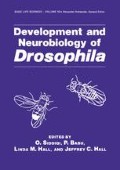Abstract
For approaching the enormous complexity of the insect brain one may choose first to study the sensory and motor periphery in the hope to finally work one’s way up to the central processing stages of the brain or, alternatively, one may parachute in the midst of the jungle, experimentally altering the brain and try to understand the concomitant changes in behavior. While with the first approach in recent years an impressive volume of basic knowledge about neural integration of sensory data and about the generation of motor patterns has been provided, only few of these studies have really been concerned with central brain functions. Of the parachutists, on the other hand, only few signs of survival have reached the outside world (e.g., Wadepuhl and Huber, 1979).
Access this chapter
Tax calculation will be finalised at checkout
Purchases are for personal use only
Preview
Unable to display preview. Download preview PDF.
References
Flügge, C., 1934, Geruchliche Raumorientierung von Drosophila melanogaster, Z. vergl. Physiol., 20: 463.
Ghysen, A., 1978, Sensory neurons recognize defined pathways in Drosophila central nervous system, Nature, 274: 869.
Hall, J.C., 1979, Control of male reproductive behavior by the central nervous system of Drosophila: dissection of a courtship pathway by genetic mosaics, Genetics, 92: 437.
Hanstrom, B., 1928, Vergleichende Anatomie des Nervensystems der wirbellosen Tiere, Springer, Berlin.
Heisenberg, M., and Götz, K.G., 1975, The use of mutations for the partial degradation of vision in Drosophila melanogaster, J. Comp. Physiol., 98: 217.
Heisenberg, M., Wonneberger, R., and Wolf, R., 1978, OptomotorblindH31 - a Drosophila mutant of the lobula plate giant neurons, J. Comp. Physiol., 124: 287.
Hertweck, H., 1931, Anatomie und Variabilität des Nervensystems und der Sinnesorgane von Drosophila melanogaster ( Meigen ), Z. wiss. Zool., 139: 559.
Howse, P.E., 1974, Design and function in the insects brain, in: “Experimental Analysis of Insect Behavior”, L.B. Browne, ed., Springer, Berlin, Heidelberg, New York.
Howse, P.E., 1975, Brain structure and behavior in insect, Ann. Rev. Entomol., 20: 369.
Huber, F., 1955, Sitz und Bedeutung nervöser Zentren für Instinkthandlunger beim Männchen von Gryllus campestris L., Z. Tierpsychol., 12: 12.
Huber, F., 1960, Untersuchungen über die Funktion des Zentralnervensystems und insbesondere des Gehirns bei der Fortbewegung und der Lauterzeugung der Grillen, Z. vergl. Physiol., 44: 60.
Klemm, N., 1976, Histochemistry of putative transmitter substances in the insect brain, Progress in Neurobiology, 7: 99.
Kloot, W.G. van der, and Williams, C.M., 1953, Cocoon construction by the Cecropia silkworm, Behavior, 5: 141.
Laudien, H., and Iken, H.-H., 1977, Ökologische Prägung und Proteinbiosynthese. Versuche mit Drosophila melanogaster Meigen, Z. Tierpsychol., 44: 113.
Manning, A., 1967, “Pre-imaginal conditioning” in Drosophila, Nature, 216: 338.
Maynard, D.M., 1967, Organization of central ganglia, in: “Invertebrate Nervous Systems”,C.A.G. Wiersma, ed., University of Chicago Press, Chicago.
Menzel, R., Erber, J., and Masuhr, T., 1974, Learning and memory in the honeybee, in: “Experimental Analysis of Insect Behavior”, L.B. Browne, ed., Springer, Berlin.
Otto, E., 1949, Untersuchung zur geruchlichen Orientierung bei Insekten, Zool. Jb., 62: 66.
Palka, J., Lawrence, P.A., and Hart, H.G., 1979, Neural projection patterns from homeotic tissue of Drosophila studied in bi-thorax mutants and mosaics, Devel. Biol., 69: 549.
Power, M.E., 1943, The brain of Drosophila melanogaster, J. Morphol., 72: 517.
Siegel, R.W., and Hall, J.C., 1979, Conditioned responses in courtship behavior of normal and mutant Drosophila, Proc. Natl. Acad. Sci. USA, 76: 3430.
Stocker, R.F., 1977, Gustatory stimulation of a homeotic mutant appendage, Antennapedia, in Drosophila melanogaster, J. Comp. Physiol., 115: 35.
Strausfeld, N.J., 1976, “Atlas of an Insect Brain”, Springer, Berlin.
Suzuki, H., and Tateda, H., 1974, An electrophysiological study of olfactory interneurones in the brain of the honeybee, J. Insect Physiol., 20: 2287.
Thorpe, W.H., 1937, Olfactory conditioning in a parasitic insect and its relation to the problem of host selection, Proc. Roy. Soc., B 124: 56.
Vowles, D.M., 1955, The structure and connections of the corpora pedunculata in bees and ants, Quart. J. Microscop. Sci., 96: 239.
Weiss, M.J., 1974, Neuronal connections and the function of the corpora pedunculata in the brain of the american cockroach, Periplaneta americana ( L), J. Morphol., 142: 21.
Wadepuhl, M., and Huber, F., 1979, Elicitation of singing and courtship movements by electrical stimulation of the brain of the grasshopper, Naturwissenschaften, 66: 320.
Author information
Authors and Affiliations
Editor information
Editors and Affiliations
Rights and permissions
Copyright information
© 1980 Springer Science+Business Media New York
About this chapter
Cite this chapter
Heisenberg, M. (1980). Mutants of Brain Structure and Function: What is the Significance of the Mushroom Bodies for Behavior?. In: Siddiqi, O., Babu, P., Hall, L.M., Hall, J.C. (eds) Development and Neurobiology of Drosophila . Basic Life Sciences, vol 16. Springer, Boston, MA. https://doi.org/10.1007/978-1-4684-7968-3_27
Download citation
DOI: https://doi.org/10.1007/978-1-4684-7968-3_27
Publisher Name: Springer, Boston, MA
Print ISBN: 978-1-4684-7970-6
Online ISBN: 978-1-4684-7968-3
eBook Packages: Springer Book Archive

